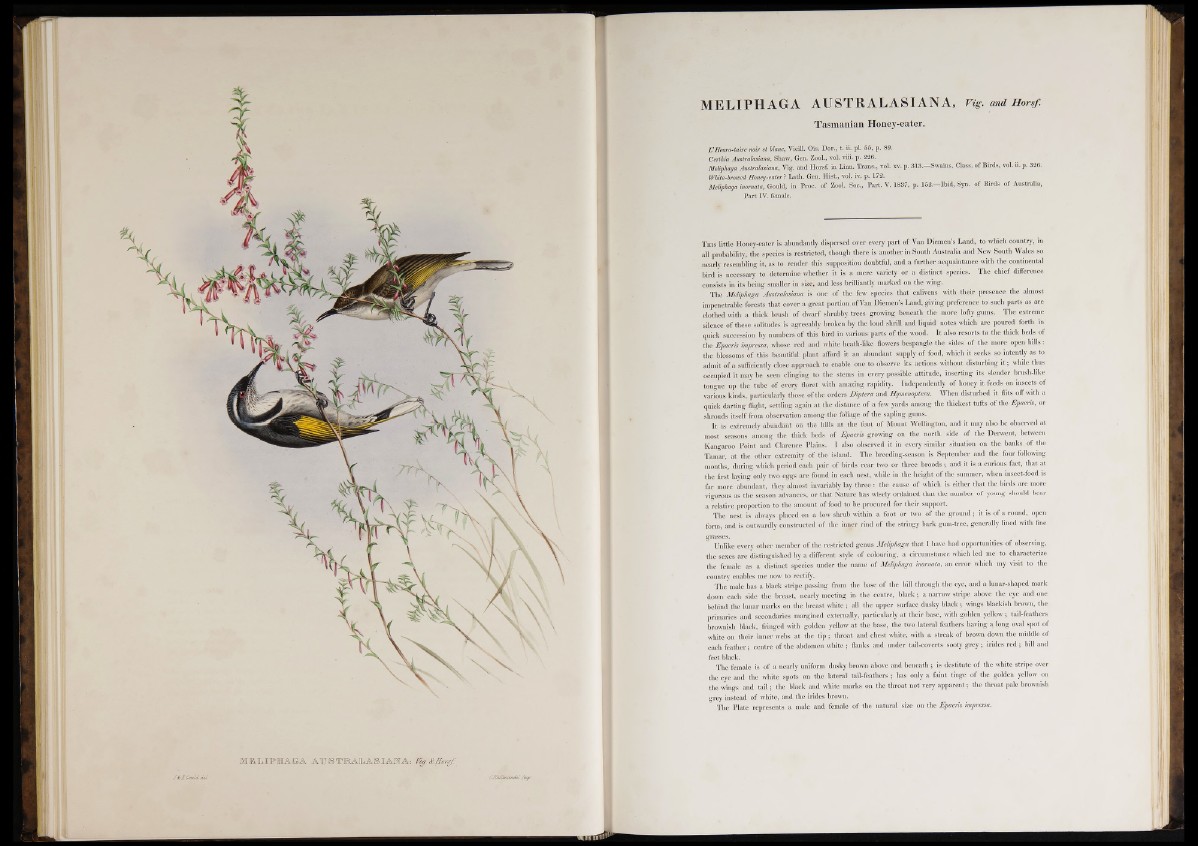
MELIPHAGA AUSTRALASIANA, Vig. and Horsf.
Tasmanian Honey-eater.
V Heoro-taire noir et blanc, Vieill. Ois. Dor., t. ii. pl. 55, p. 89.
Certhia Australasiana, Shaw, Gen. Zool., vol. viii. p. 226.
MeliphagaAustralasians, fig . and Horsf, in Linn. Trans., v s l. xr. p. 313.—Swains. Class, of Birds, vol. a p. 326.
Whtte-browed Honey-eater ? Lath. Gen. Hist., Vol. iv. p. 172.
Meliphtga immota, Gould, in Proo. of gaol1.' Soo., Part. V. 1837, p. i f fr Ibid, Syn. of Birds of Australia,
Part IV. female.
T h is little Honey-eater is abundantly dispersed over every part o f Van Diemen’s Land, to which country, m
all probability, the species is restricted, though there is another in South Australia and New South Wales so
nearly resembling it, as to render this supposition doubtful, and a further acquaintance with the continental
bird is necessary to determine whether it is a mere variety or a distinct species. The chief difference
consists in its being smaller in size, and less brilliantly marked on the wing.
The Meliphaga Australasiana is one of the few species that enlivens with their presence the almost
impenetrable forests that cover a great portion, of Van Diemen’s Land, giving preference to such parts as are
clothed with a thick brush of dwarf shrubby trees growing beneath the more lofty gums. The extreme
silence of these solitudes is agreeably broken by the loud shrill and liquid notes which are poured forth in
quick succession by numbers o f this bird in various parts o f the wood. It also resorts to the thick beds of
the Epacris impressa, whose red and white heath-like flowers bespangle the sides of the more open hills:
the blossoms o f this beautiful plant afford it an abundant supply of food, which it seeks so intently as to
admit of a sufficiently close approach to enable one to observe its actions without disturbing it; while thus
occupied it may be seen clinging to the stems in every possible attitude, inserting its slender brush-like
tongue up the tube of every floret with amazing rapidity. Independently of honey it feeds on insects of
various kinds, particularly those of the orders Diptera and Hymenoptera. When disturbed it flits off with a
quick darting flight, settling again at the distance of a few yards among the thickest tufts of the Epacris, or
shrouds itself from observation among the foliage o f the sapling gums.
It is extremely abundant on the hills at the foot of Mount Wellington, and it may also be observed at
most seasons among the thick beds of Epacris growing on the north side of the Derwent, between
Kangaroo Point and Clarence Plains. I also observed it in every similar situation on the banks o f the
Tamar, at the other extremity of the island. The breeding-season is September and the four following
months, during which period each pair of birds rear two or three broods ; and it is a curious fact, that at
the first laying only two eggs are found in each nest, while in the height of the summer, when insect-food is
far more abundant, they almost invariably lay three : the cause o f which is either that the birds are more
vigorous as the season advances, or that Nature has wisely ordained that the number of young should bear
a relative proportion to the amount of food to be procured for their support.
The nest is always placed on a low shrub within a foot or two of the ground; it is of a round, open
form, and is outwardly constructed of the inner rind of the stringy bark gum-tree, generally lined with fine
grasses.
Unlike every other member o f the restricted genus Meliphaga that I have had opportunities of observing,
the sexes are distinguished by a different style of colouring, a circumstance which led me to characterize
the female as a distinct species under the name of Meliphaga inornata, an error which my visit to the
country enables me now to rectify.
The male has a black stripe passing from the base of the bill through the eye, and a lunar-shaped mark
down each side the breast, nearly meeting in tbe centre, black; a narrow stripe above the eye and one
behind the lunar marks on the breast white ; all the upper surface dusky black ; wings blackish brown, the
primaries and secondaries margined externally, particularly at their base, with golden yellow; tail-feathers
brownish black, fringed with golden yellow at the base, the two lateral feathers having-a long oval spot of
white on their inner webs at the tip ; throat and chest white, with a streak of brown down the middle of
each feather; centre of the abdomen white ; flanks and under tail-coverts sooty grey; irides red; bill and
feet black.
The female is of a nearly uniform dusky brown above and beneath ; is destitute of the white stripe over
the eye and the white spots on the lateral tail-feathers ; has only a faint tinge of the golden yellow on
the wings and ta il; the black and white marks on the throat not very apparent; the throat pale brownish
grey instead of white, and the irides brown.
The Plate represents a male and female of the natural size on the Epacris impressa.